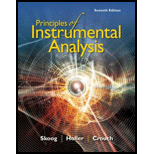
(a)
Interpretation:
The type of noises that can be reduced by decreasing the temperature of measurement needs to be determined.
Concept introduction:
Chemical analyses are related with two types of noise which are chemical noise and instrumental noise. Chemical noise is due to reasons that affect the chemistry of the system being analyzed. Instrumental noise is components of the instrument. There are four types of instrumental noise and they are thermal noise, shot noise, flicker noise and environmental noise.
(b)
Interpretation:
The type of noise that can be reduced by increasing the frequency used for measurement needs to be determined.
Concept introduction:
Chemical analyses are related with two types of noise which are chemical noise and instrumental noise. Chemical noise is due to reasons that affect the chemistry of the system being analyzed. Instrumental noise is components of the instrument. There are four types of instrumental noise and they are thermal noise, shot noise, flicker noise and environmental noise. Among them flicker noise and environmental noise are frequency dependent thermal noise and shot noise are frequency independent.
(c)
Interpretation:
The type of noise that can be reduced by decreasing the band width of the measurement needs to be determined.
Concept introduction:
Radiation does not only come from human-made sources, but it can also come from natural sources.
Trending nowThis is a popular solution!

- What is the final product when D-galactose reacts with hydroxylamine?arrow_forwardIndicate the formula of the product obtained by reacting methyl 5-chloro-5-oxopentanoate with 1 mole of 4-penten-1-ylmagnesium bromide.arrow_forwardIn the two chair conformations of glucose, the most stable is the one with all the OH groups in the equatorial position. Is this correct?arrow_forward
- please help me with my homeworkarrow_forwardhelparrow_forwardThe temperature on a sample of pure X held at 1.25 atm and -54. °C is increased until the sample boils. The temperature is then held constant and the pressure is decreased by 0.42 atm. On the phase diagram below draw a path that shows this set of changes. pressure (atm) 2 0 0 200 400 temperature (K) Xarrow_forward
- QUESTION: Answer Question 5: 'Calculating standard error of regression' STEP 1 by filling in all the empty green boxes *The values are all provided in the photo attached*arrow_forwardpressure (atm) 3 The pressure on a sample of pure X held at 47. °C and 0.88 atm is increased until the sample condenses. The pressure is then held constant and the temperature is decreased by 82. °C. On the phase diagram below draw a path that shows this set of changes. 0 0 200 temperature (K) 400 аarrow_forwarder your payment details | bar xb Home | bartleby x + aleksogi/x/isl.exe/1o u-lgNskr7j8P3jH-1Qs_pBanHhviTCeeBZbufuBYT0Hz7m7D3ZcW81NC1d8Kzb4srFik1OUFhKMUXzhGpw7k1 O States of Matter Sketching a described thermodynamic change on a phase diagram 0/5 The pressure on a sample of pure X held at 47. °C and 0.88 atm is increased until the sample condenses. The pressure is then held constant and the temperature is decreased by 82. °C. On the phase diagram below draw a path that shows this set of changes. pressure (atm) 1 3- 0- 0 200 Explanation Check temperature (K) 400 X Q Search L G 2025 McGraw Hill LLC. All Rights Reserved Terms of Use Privacy Cearrow_forward
 Principles of Instrumental AnalysisChemistryISBN:9781305577213Author:Douglas A. Skoog, F. James Holler, Stanley R. CrouchPublisher:Cengage Learning
Principles of Instrumental AnalysisChemistryISBN:9781305577213Author:Douglas A. Skoog, F. James Holler, Stanley R. CrouchPublisher:Cengage Learning

